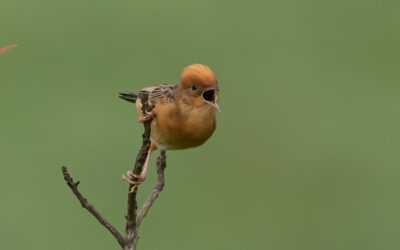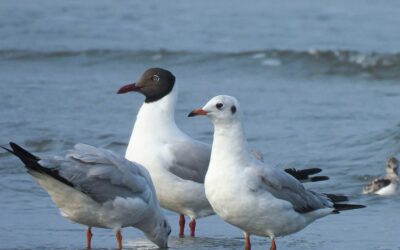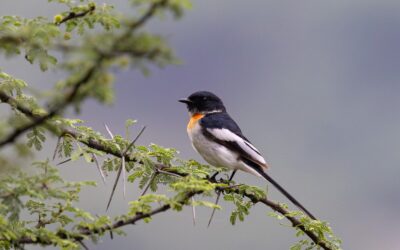Results
We are delighted to announce the results of the 2016 eBird-India data challenge! The challenge was to download eBird data from India, and analyse, summarise, & visualise it into something new and interesting.
We received six entries in all, some from individuals; others from people working in teams. Descriptions of each of the entries are below. Our panel of esteemed jury members had a difficult time deciding which entry stood out ahead of the others. They finally decided on a winning entry, which was submitted by
ADITYA NAYAK
Congratulations, Aditya — you have won five stunning framed photographs of Indian wildlife and landscapes, plus a copy of the book One Wild Bird At a Time: Portraits of Individual Lives, by Bernd Heinrich.
A brief description of each of the entries is below, in alphabetical order. Thank you to every one of you for your interest and efforts!
Aditya Nayak
eBird data for Uttara Kannada district in Karnataka: Comparisons with historical studies, data interpretation and geographical data gaps
In this project, Aditya compared eBird records from Uttara Kannada district against comprehensive bird lists prepared in the past 150 years to examine which species are expected but have not been reported recently. He also examined the spatial distribution of eBirded locations in the district, concluding that birding activity was very skewed to a single location. An analysis of reporting frequency suggested a bias against common birds, possibly resulting from the kinds of locations that are preferred for birding.
Ajay Gadikar
[Distribution analysis of India species]
In this project, Ajay assessed the distribution of selected bird species across India, and then asked how closely these distributions matched those given in standard field guides. The found a close correspondence between the two, but also suggested further analyses of multiple species in all seasons.
Angel Luis Robles Fernandez
[Gaps and information in India bird data]
In this project, Angel calculated an index of effort for each list; and summed up the total effort index for different bioregions of India to create a map depicting how eBirdig effort varies across the country. The project also looked at some macroecological patterns, including monthly richness maps of India, and other such patterns.
Asani Bhaduri and team
Birds of India: A perspective of IUCN categories from eBird dataset
This project intended to uncover the best birding spots for birds of different threat categories — especially “Least Concern” species. It also identified “Least Concern” species unique to each State. A similar analysis was carried out for species in other IUCN threat categories, including Near Threatened, Vulnerable, Endangered, and Critically Endangered, with particular attention to the Critically Endangered Gyps vulture.
Karthik Athreyas
[What are the best locations to find particular species?]
Karthik took eBird data from the state of Karnataka to ask, for a subset of species, which locations are the best places to find a given species. He also examined the counts of these species over the four-year period 2012-2016 to ask whether counts have increased, decreased or stayed roughly the same.
Siddhartha Gadgil
Not of a feather but flock together
This project examined the propensity of pairs of species to occur together in lists, which would imply that they either share key habitat requirements, or they depend on each other in some way. The project first looked at pairwise co-occurrences, but since those could be explained simply by two species occurring in the same geography, Siddhartha also conducted further analyses to take into account geographic co-occurrence, to get into more detail.
Thank you and well done to all those who entered the Data Challenge!
Note: in view of the small number of entries, the panel of jury members decided not to award any special mention prizes.





Views for Suggestion no 5, Mike ebird have started profile page for each members but some way to contact is missing. Might b email I’d or any social media links or such. Will help to contact the checklist submitted for new locations who travel for birding.
Or for getting more data for any sort of research, like from last try for learning year around migration of Indian skimmer, had seen they move from Gujarat to chambal during Oct end through Rajasthan. But not much details from Rajasthan. Might have contacted few local birders who had recorded previously.
Yes,communication / discussion with eBirders w.r.t.checklist, self checklist,any ID issues are not discuss.Some method is required.Regarding monthly challenge…declared by eBird,great participation by Birders,eBird of month declared …But what’s the outcome of eBird Monthly challenge not discuss…some method or links is essential.
The Common Name should be assign for each of IBA by eBird / BIRD COUNT OF INDIA or any other related agency wih definite identified boundries.When any eBird submit checklist from said IBA a previously decided Name of IBA should be display for eBirder.
For example— Hatnur Dam is recent & only one IBA in Jalgaon District-Maharashtra.But eBirders submit their checklist like Hatnur dam,Hatnur dam & surrounding area,Tandalwadi,Damleft,Dam right,cannal side,IBA etc.
Due to which IBA or Hotspot not identified some of the lists of same area.If you assign a Fix or particular ID for each IBA with decided boundaries /area future data analysis is correct for The said IBA.
I myself use different names previously for different locations in same IBA …HATNUR.And always hesitate how I can give same name as IBA at different locations in same area / locations… sometimes more than 5KM apart from each other.When we analyse the IBA as one patch/area different locations( in same IBA) used by eBirder should identify as Single ID decided by eBird ¬ by eBirder.
Thank you Sir. One of the problems is that we do not have boundaries of all IBAs in digital form, otherwise what you suggest would be possible. At the moment, hotspot naming is not under the user’s control — but any personal location (ie, not suggested or added to a hotspot) is under the user’s control. For personal locations, the name given is less important than giving the precise geographical location (lat-long).
In the future (we hope soon), eBird will move away from designating hotspots as point locations, and instead delineate hotspot boundaries — when this happens, all lists (including lists from personal locations) with latlong within the hotspot boundary will be aggregated into that hotspot for output. It will also be possible to have ‘daughter’ hotposts within a single ‘parent’ hotspot. For example, Hatnur Dam hotspot will be able to include Hatnur Backwaters as a daughter.
This IBA HOTSPOT issue is important for analysis of bird count,migration,Nesting & Nesting Behaviour, Inter – dependency of birds,etc.Importance is increased when Habitat is Mixed like water body,Farm land,Near by river bed,wet land,Jungle area,Grass Land & much more.
When I submitted Question in Question pool error message seen & question not submitted
cURL error 28: Operation timed out after 1000 milliseconds with 0 bytes received
Is there any limit of nos of words?
Sir, is this what you submitted?
—
The Common Name should be assign for each of IBA by eBird / BIRD COUNT OF INDIA with definite identified boundries.When any eBird submit checklist from said IBA a previously decided Name of IBA should be display for eBirder.
—
This was received by us on 2 Nov, but not added to the list of questions as it is a suggestion about an eBird feature rather than a suggestion for how to analyse the data. Please correct me if I’m wrong. Thanks!
OK
OK
How should I get male,female or juvenile population of a particular bird specis ref to area/location/habitat/field.How I locate breeding locations of migrated birds in India for observations?
It is very difficult to identify & update data as male,female,juvenile in birds.more difficult Nonbr/br stages.Checklist should be link with respective male,female species photographs & audio calls.
Could you clarify how to submit?
By email: [email protected]
There is data collection method for each bird species in the tabular format as male/female/juvenile etc with breeding codes.99% checklists without this information.Yes it is very difficult also to submit all such information in field since you have to record bird after fractions of second of presence infront of you.
But if any immediate link provisions or any offline data methods are there next to bird name to access photographs /audio calls/etc to identity male/female/juvenile/br-nonbr plumage…eBirder will take interest to log information as male/female after comparing the immediate data available infront of bird name.
We have photographs & audio calls in media sections & one can access with name of species.Same data can be available with link infront of species name in checklist.Due to ready avability of such information eBirder will take interest to identify /login specific information.
Here is our future need that photographs & audio calls should segregated with male/female marks.Then only it is easy for eBirder to observe/access / record /update information as male/female, from which respective population information is possible.
Same thing can possible with breeding codes,I think so.If Breeding code is updated properly.
Replied what is in my mind.Guide me accordingly.
Any updates as to when the results will be processed? Would be interesting to also see all the wonderful submissions to this challenge made public once this is done!
Thanks for your enquiry. We should have the results out next week; apologies to all for the delay!
Congratulations Aditya Nayak for winning the ebird data challenge.
Thanks Ajay for the wishes and Birdcount India for the data challenge! All the entries look great, would it be possible to link the pdfs/images of all the entries so that it is accessible to us?
The Results page is not working. seem to be broken